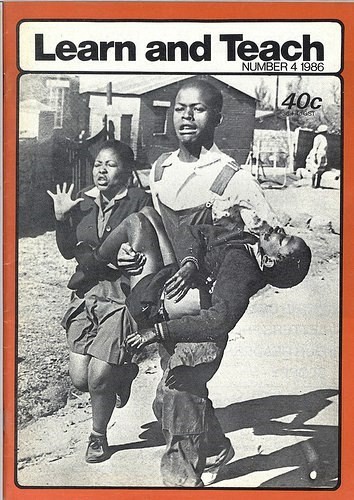
Learn and Teach, 1986, which was promptly banned when issued
13 June 2016
Three decades ago, a small team of a radical adult literacy magazine was putting the finishing touches to their latest edition, Learn and Teach magazine number 4, 1986. On its cover was the iconic photo by Sam Nzima of the first reported fatal incidents of 16 June 1976, the injured and dying Hector Pieterson in the arms of Mbuyisa Makhuba, and running anxiously alongside, Antoinette Sithole.
Commemorating a decade since ‘76 was too much for the apartheid state to tolerate. No sooner had the magazine been published than it was banned.
President P.W. Botha had just instituted the second state of Emergency on 12 June 1986, further clamping down on freedom of speech, movement, and organisation. The alternative media groups such as Work in Progress, the South African Labour Bulletin, South, The Indicator newspaper, Vrye Weekblad, the Weekly Mail, Grassroots, Saamstaan and a number of others played an invaluable role for people resisting apartheid.
Learn and Teach’s target audience was newly literate adult learners with at least four or five years of formal education, many of whom were blue collar workers and unemployed people.
Independent evaluators of the magazine, Rachel Jenkins and Klaas Mashishi, wrote in 1985 that ‘for some people, the magazine is the only published alternative to the information they receive through SABC news … the mouthpiece of government’.
‘The magazine seems to have developed a reputation for reliability and veracity. People believe what they read in it, while they do not necessarily believe what they hear on SABC or what is written in newspapers,’ they wrote.
Learn and Teach staff noted that ‘one of our biggest and most frustrating problems is the necessity of self-censorship to comply with these [emergency] regulations. These frustrations are compounded by the uncertainty and unease that hangs over all alternative publications (1986 Annual Report 1986:11)’.
The magazine’s lawyer, Kathleen Satchwell (now judge), “encouraged” them to push the envelope, and was ready to fight to repeal the bans as she had done before. Putting a matter before the Publications Appeal Board usually took weeks, which was ample time to get the magazine to hit the streets through a community, church and union driven distribution strategy. Other plans devised to beat the bannings were to republish stories contained in the banned edition.
Annie Smythe had just taken the job as editor after years of sterling leadership by Marc Suttner, supported by other staff members like the late Tebogho Maitse and Stephen Rothenburg. In a 2014 interview, she recalled the banning whilst it was still at the printers: “And then it got delivered to the office a few days later, wrapped in plastic for the whole world to see. And then, we very cheekily asked the lawyer … if he would hide all 30,000 copies in his safe … Then one day, one of the sellers arrived at the office – I think his name was Mojalefa – and he was very indignant that people were selling an issue that he hadn’t been given: the June memorial issue. It turned out that the lawyer’s messenger was selling them from his safe.”
The 40th anniversary of the June ’76 uprisings presents an opportunity to make the magazine available online, Learn and Teach 4, 1986, for the first time.